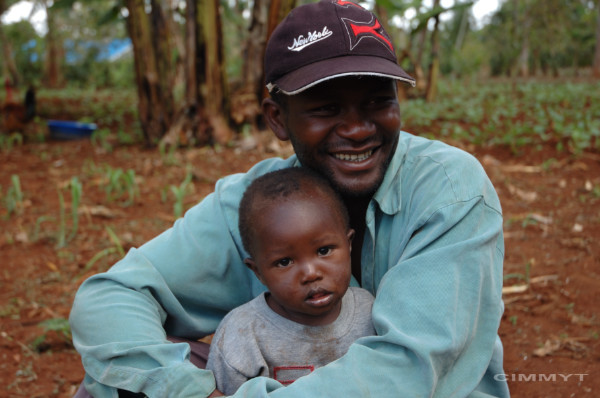
Promoting HIV self-testing amongst male partners in Kenya

Context
Sub-Saharan Africa witnesses 88 per cent of the world’s HIV-related deaths amongst children under the age of 15 years. In Kenya, 6.5 per cent of pregnant women live with HIV/AIDS. Each year, between 38,000 and 42,000 children are infected with HIV via mother-to-child transmission. Since government ANC centres provide HIV prevention, testing and counselling (HTC) services to pregnant women, it is likely that more Kenyan women than men have been tested for HIV.
ANC centres in Kenya experience heavy traffic from pregnant women every year and see near universal uptake of HTC amongst their clients. However, there is hardly any uptake of these services among the male partners of these clients.
In 2014, researchers from Jhpiego and the Medical University of South Carolina conducted a study to determine whether providing pregnant women with oral HIVST kits to give to their partners could improve rates of male partner HIV testing. The kits included information cards produced by the Kenyan Ministry of Health.
The randomised controlled evaluation was carried out at the 14 health facilities that received the highest volume of ANC clients in eastern and central Kenya. These facilities were divided into three arms, consisting of one intervention group (arm 3) where HIVST kits were distributed and two control groups (arms 1 and 2) where standard care was provided.
Evidence
Overall, the evaluation findings revealed a high uptake (88 per cent) of HIVST kits in the intervention group, suggesting a willingness by male partners to use the kits. The method was shown to be effective, with an overwhelming number of women (98 per cent) in arm 3 discussing HIV testing with their male partners, resulting in increased use of self-testing kits.
Additionally, the usability and acceptability of self-test kits were verified. A large number of women and men said they understood the instructions easily, the tests were easy to conduct, and it was easy to read and comprehend the test results.
Evidence impacts
[W]e know from the study that male partner testing can increase by using the HIV self-test kit. Now, what government did was to look at it more holistically and say all right, now we know that self-testing is a good idea. So, they incorporated that in the guidelines. Since ANC offering self-test kits has been included in the HIV self-testing guidelines …, ANC clients and their partners know that that's one of the options.
Type of impact: Change policies or programs
Decision makers use findings from an evaluation or systematic review to adjust their programming to fix targeting, cash transfer amounts, training modules or other factors that inhibit the policy or programme’s ability to achieve its intended impacts.
This is one of 3ie’s seven types of evidence use. Impact types are based on what we find in the monitoring data for an evaluation or review. Due to the nature of evidence-informed decision-making and action, 3ie looks for verifiable contributions that our evidence makes, not attribution.
Read our complete evidence impact typology and verification approach here.
Close windowTo address the male testing gap, NASCOP opted to include ANC centres as a delivery channel for HIVST, based on advocacy around the evaluation findings. The researchers had presented their findings to the NASCOP Technical Working Group on HIV, who were in the process of designing the HIVST Operational Manual. The Ministry of Health also acknowledged the role ANC centres play in improving HIVST coverage.
Type of impact: Inform global guidelines and policy discussions
When findings from an evaluation or review can be traced to discussions or actions. Examples include governments or multilateral or bilateral donors’ mentioning the findings to inform policy or programming. To date, we have only one case of an individual impact evaluation informing global health guidelines. WHO guidelines require that the guidance is based on randomised evaluation evidence.
This is one of 3ie’s seven types of evidence use. Impact types are based on what we find in the monitoring data for an evaluation or review. Due to the nature of evidence-informed decision-making and action, 3ie looks for verifiable contributions that our evidence makes, not attribution.
Read our complete evidence impact typology and verification approach here.
Close windowWHO cites 3ie evaluation findings in strongly recommending that HIVST be offered and in supporting implementation and scale-up of ethical, acceptable and evidence-based approaches to HIVST. WHO also refers to ANC centres as an effective delivery mechanism for reaching men who would not otherwise be tested. The recommendation appears in the organisation's Consolidated guidelines on HIV testing services released in December 2019, citing evidence from various sources, including the research conducted by 3ie. These update the previous guidelines on HIV Self-testing and Partner Notification released in 2016, that also cited the evaluation findings. The updated guidelines note that HIVST has emerged as an effective tool to expand testing among people at risk of HIV who may not otherwise test and those at ongoing risk who need to test frequently.
Suggested citation
International Initiative for Impact Evaluation (3ie), 2020. Promoting HIV self-testing amongst male partners in Kenya [online summary], Evidence Impact Summaries. New Delhi: 3ie.
Evidence impact summaries aim to demonstrate and encourage the use of evidence to inform programming and policymaking. These reflect the information available to 3ie at the time of posting. Since several factors influence policymaking, the summaries highlight contributions of evidence rather than endorsing a policy or decision or claiming that it can be attributed solely to evidence. If you have any suggestions or updates to improve this summary, please write to influence@3ieimpact.org